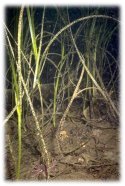|
|
Eelgrass Habitat |
Quick links |
|
Introduction |

This webpage will familiarize students with the eelgrass habitat. Students will learn what eelgrass is, why it is important, and how it is related to other organisms.
grade level: 7th thru 9th
for the teacher: Background information on eelgrass habitats may be found at these resource sites:
for everyone:
This webpage uses JavaScript to provide several extra functions.
|
Lesson
|
The objectives of this lesson are:
|
Vocabulary
|
| angiosperm | ecosystems | detritus | estuaries | genus | larvae | perennial | rhizomes | photosynthesis | |
Story |
What is eelgrass?
Eelgrass is neither a grass nor a seaweed. It is an angiosperm, or flowering plant that can live for many years, a perennial. Why is eelgrass so important?Eelgrass habitats are among the most productive and biologically diverse ecosystems on the planet. Materials from these habitats can support many organisms locally and far offshore, as deep as 30,000 feet in the ocean. Eelgrass has many valuable ecological functions.
Eelgrass habitats have great economic impact worldwide.
As food, eelgrass has far-reaching effects. Because it is a primary producer, it forms the base of a food web. Many different kinds of organisms depend on it directly or indirectly. These include:
Less than 5% of eelgrass is eaten by grazers because it has a high amount of cellulose, which most animals cannot digest. Its main function as food is to produce detritus, or decaying plant matter. Bacteria, worms, and crabs feed on this material locally and pass it up to other animals in the food web. Some of the detritus is carried offshore many miles where it is fed upon by fish and other animals thousands of feet below the ocean's surface. Where does eelgrass grow?Eelgrass grows in estuaries, bays, lagoons, and other marine environments where water is clear and light is plentiful. Eel grasses grow in shallow salty waters with muddy or sandy bottoms. Eelgrass habitats can be found from Alaska to Australia, in the Chesapeake Bay and off the coasts of Florida, California, and coastal areas of Europe and Asia. Eelgrass may be found growing just a few feet under water or at depths up to 100 feet or more if the water is unusually clear (e.g. some areas along the California coast). How deep eelgrass grows depends on the amount of light available and on the clarity of the water. Temperature and salinity also affect eelgrass health. |
Summary |
Eelgrass is a flowering plant that grows under water in estuaries and in shallow coastal areas. Eelgrass forms the base of some biologically rich ecosystems and thus supports many varieties of organisms, including some economically valuable fish and shellfish. Eelgrass performs many important ecological functions.
Most animals cannot eat eelgrass because they cannot digest the cellulose in it, but as detritus, eelgrass is a rich source of nourishment throughout the food web. Eelgrass habitats are found in most of the world's coastal regions except at extremely high latitudes. |
Vocabulary
|
| angiosperm | ecosystems | detritus | estuaries | genus | larvae | perennial | rhizomes | photosynthesis | |
Self test |
Now that you have read through the material on this page, how about a little quiz to confirm that you've learned the major points about eelgrass habitats? Once you've answered the questions, you can press the 'Score it' button and immediately find out how you did. You can also get a detailed explanation of which questions you answered incorrectly. |
Student activity |
|
Additional lessons |
If you liked this lesson, be sure to visit the other lessons in the series. |
